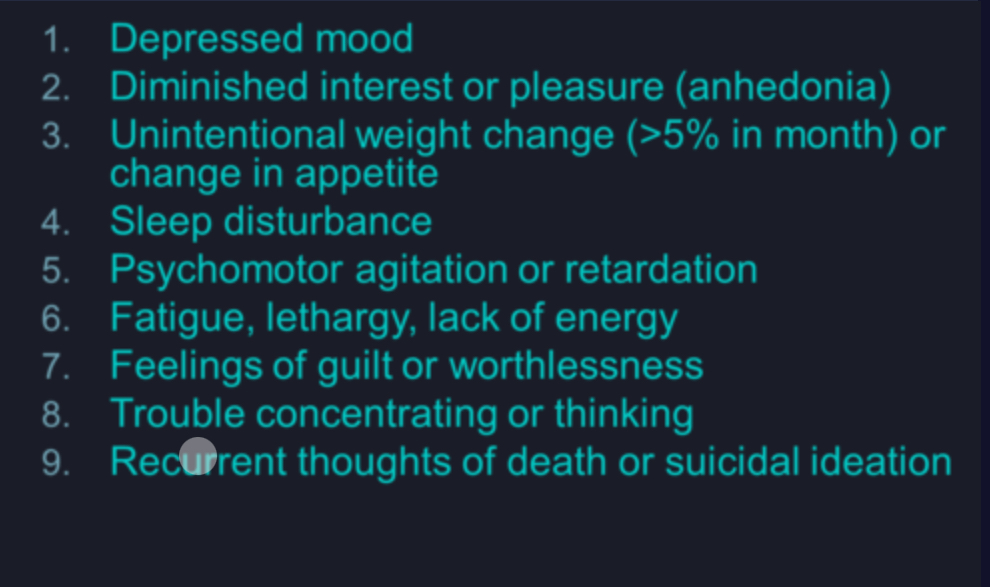intro to psychiatry depression and anxiety✅
1/49
There's no tags or description
Looks like no tags are added yet.
Name | Mastery | Learn | Test | Matching | Spaced |
|---|
No study sessions yet.
50 Terms
Psychiatrist
A physician who specializes in the diagnosis and treatment of mental disorders (MD + Residency)
Psychotherapy, Psychopharmacology, Somatic therapies, Lifestyle modification
Psychiatrists treat patient through (4)
DSM-5-TR
dictionary-like descriptor for psychiatric disorders, diagnostic tool
Mental Disorder
a syndrome characterized by clinically significant disturbance in an individual's cognition, emotion regulation, or behavior that reflects a dysfunction in the psychological, biological, or developmental processes underlying mental functioning
Significant Distress and/or Disability
mental disorders are associated with this in social, occupational, or other important activities
not a mental disorder
An expectable or culturally approved response to a common stressor or loss is
Socially deviant behavior
not mental disorders unless the deviance from normal results from a dysfunction in the individual
Significant Distress and/or Disability
To diagnose a mental disorder the condition must cause
psychotherapies
Involve addressing an individual's thoughts, behaviors, emotions, and relationships through developing insight, changing cognitions and changing behaviors
Pharmacotherapies
Drugs are often symptom specific, not diagnosis specific
Somatic Therapies
Involve stimulating neural circuits
Electroconvulsive therapy, TMS, Deep brain stimulation, Vagal nerve stimulation, Phototherapy
Types of Somatic Therapies (5)
Phototherapy
Form of somatic therapy used to tread seasonal affective disorder
Major Depressive Episode (MDE)
At least five of numbered must be present in 2-week period, and either 1 or 2 must be included (can't be due to substance, or other psychiatric disorder)

Alexithymia
inability to name emotions makes depression diagnosis harder
2/3
chance that a first line antidepressant will work for an individual
50%
likelihood after 1 MDE to have another
80%
likelihood after 2 MDE to have another
Major Depressive Disorder (MDD)
recurrent illness of major depressive episodes
25-30
Avg age of onset for MDD (which can be sudden or gradual)
2-3
MDD is how many times more prevalent if there is a first-degree biological relative who suffers from it
ACES
Negative events that occur in childhood that are associated with increased rates of health conditions, include abuse, neglect, and household, familial, and environmental exposures
Environmental element
There must be an ___ ___ in addition to genetic vulnerability
Medial Prefrontal Cortex, Hypothalamus + HPA Axis, Hippocampus
Brain regions most implicated by major depression, become reduced in volume, likely reflecting impaired neurogenesis
17%
Lifetime prevalence for major depressive disorder (MDD) in adults
women
Lifetime prevalence for major depressive disorder (MDD) in adults is higher for which gender
14.4 Billion/yr
Estimated cost to the Canadian Economy of MDD (people less productive)
reduced signaling (not NT lvls)
Depression is the result of a functional deficiency of noradrenaline (NA) and/or 5-hydroxytryptamine (5-HT, serotonin) at specific synapses in the central nervous system. This "functional deficiency" is caused by
60-80%, 30-40%
Antidepressant Response rates of %, remission %
1yr
Antidepressants should be taken for how long after an MDE
Treatment Emergent Suicidality
patient changes from antidepressants the first week because the patient has increased energy, but mood remains low
MAO inhibitors
allowing the amine neurotransmitters to accumulate within the nerve terminal by preventing their enzymatic breakdown, many side effects
tricyclic antidepressants
Inhibit the active reuptake of NA and 5-HT back into nerve terminals, resulting in an increased functional availability of these neurotransmitter amines at central receptors, many side effects
Selective Serotonin Reuptake Inhibitors
Strong inhibitors of 5-HT reuptake, but unlike the TCAs, they and their metabolites have little effect on NA reuptake into nerve terminals. (First line)
Serotonin-Norepinephrine Reuptake Inhibitors
Inhibit the reuptake of 5-HT and NA from the synaptic cleft (First line)
Electroconvulsive Therapy (ECT)
Used for severe, treatment resistant depression (or with psychotic features) works with antidepressants and antipsychotics, works in 4-6mo. unless used ongoing to prevent relapse
Antidepressants
Useful for the treatment of a number of other disorders, including anxiety disorders, eating disorders, some personality disorders, and chronic pain syndromes.
Anxiety
itself is a normal adaptive response to perceived threats or danger
18%
The 12-month prevalence rate for having an anxiety disorder is around
Panic Disorder
Unpredictable and recurrent attacks of panic characterized by upsetting physical symptoms such as tachycardia, chest pain, sweating, tremor, nausea, and overwhelming sensations of fear or loss of control. (can lead to agoraphobia)
Social Anxiety Disorder
Extreme and persistent anxiety about social situations, leading to avoidance of those situations, or pronounced anxiety attacks on exposure or even on anticipation of exposure to the situation.
Specific Phobias
Clinically significant anxiety provoked by exposure to a specific feared object or situation, often leading to avoidance behaviour.
Generalized Anxiety Disorder
Excessive anxiety and worry, occurring most days for more than six months, with symptoms of motor tension, autonomic hyperactivity, apprehensive expectation, vigilance and scanning.
serotonergic and noradrenergic
Anxiety disorders are thought to be due to overactivity of neural circuits involved in fight/flight/freeze behavior
Mostly involving what synapses (2)
thalamus
hub for interpreting sights and sounds; it takes input and then sends signals to the appropriate part of the cortex
Amygdala
triggers the fear response. It sends signals to the locus ceruleus as well as the hypothalamus and pituitary which active hormonal responses
Hippocampus
stores raw information from the senses along with the emotional tone and links memories to emotional states
locus ceruleus
receives signals from the amygdala and sends signals via noradrenaline to the rest of the body to trigger a classic fear response or flight or fight response.
Antidepressants, Benzodiazepines, Beta-blockers
Antianxiety medications
benzodiazepines
interact with binding sites on the GABA-A receptor and potentiate GABA-mediated increases in chloride permeability